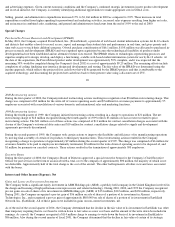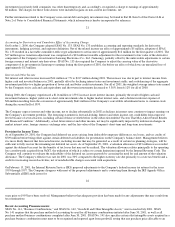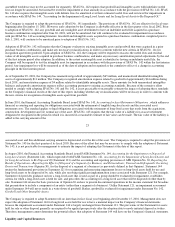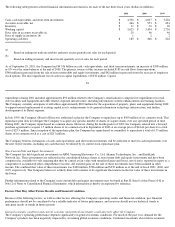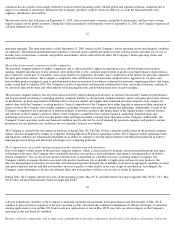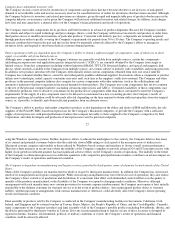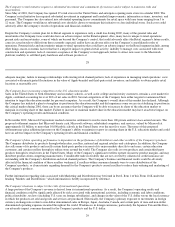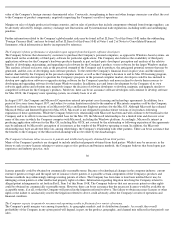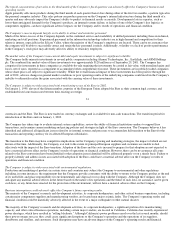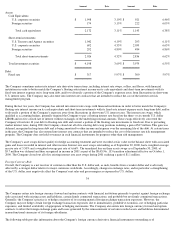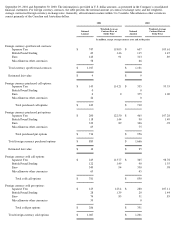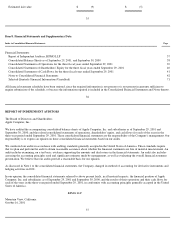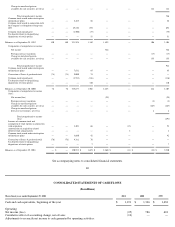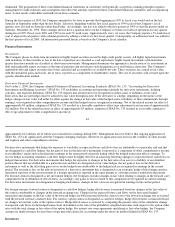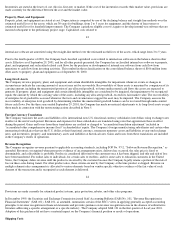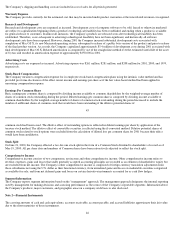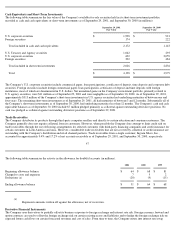Apple 2001 Annual Report Download - page 27
Download and view the complete annual report
Please find page 27 of the 2001 Apple annual report below. You can navigate through the pages in the report by either clicking on the pages listed below, or by using the keyword search tool below to find specific information within the annual report.
The Company sometimes enters into interest rate derivative transactions, including interest rate swaps, collars, and floors, with financial
institutions in order to better match the Company's floating-rate interest income on its cash equivalents and short-term investments with its
fixed-rate interest expense on its long-term debt, and/or to diversify a portion of the Company's exposure away from fluctuations in short-term
U.S. interest rates. The Company may also enter into interest rate contracts that are intended to reduce the cost of the interest rate risk
management program.
During the last two years, the Company has entered into interest rate swaps with financial institutions in order to better match the Company's
floating-rate interest income on its cash equivalents and short-term investments with its fixed-rate interest expense on its long-
term debt, and/or
to diversify a portion of the Company's exposure away from fluctuations in short-term U.S. interest rates. The interest rate swaps, which
qualified as accounting hedges, generally required the Company to pay a floating interest rate based on the three- or six-month U.S. dollar
LIBOR and receive a fixed rate of interest without exchanges of the underlying notional amounts. These swaps effectively converted the
Company's fixed-rate 10 year debt to floating-rate debt and convert a portion of the floating rate investments to fixed rate. Due to prevailing
market interest rates, during 2001 the Company closed out all of its existing debt swap positions realizing a gain of $17 million. This gain was
deferred, recognized in long-term debt and is being amortized to other income and expense over the remaining life of the debt. At certain times
in the past, the Company has also entered into interest rate contracts that are intended to reduce the cost of the interest rate risk management
program. The Company does not hold or transact in such financial instruments for purposes other than risk management.
The Company's asset swaps did not qualify for hedge accounting treatment and were recorded at fair value on the balance sheet with associated
gains and losses recorded in interest and other income. Interest rate asset swaps outstanding as of September 30, 2000, had a weighted-average
receive rate of 5.50% and a weighted-average pay rate of 6.66%. The unrealized loss on these assets swaps as of September 30, 2000, of
$5.7 million was deferred and then recognized in income in 2001 as part of the SFAS No. 133 transition adjustment effective on October 1,
2000. The Company closed out all of its existing interest rate asset swaps during 2001 realizing a gain of $1.1 million.
Foreign Currency Risk
Overall, the Company is a net receiver of currencies other than the U.S. dollar and, as such, benefits from a weaker dollar and is adversely
affected by a stronger dollar relative to major currencies worldwide. Accordingly, changes in exchange rates, and in particular a strengthening
of the U.S. dollar, may negatively affect the Company's net sales and gross margins as expressed in U.S. dollars.
34
The Company enters into foreign currency forward and option contracts with financial institutions primarily to protect against foreign exchange
risks associated with existing assets and liabilities, certain firmly committed transactions, and probable but not firmly committed transactions.
Generally, the Company's practice is to hedge a majority of its existing material foreign exchange transaction exposures. However, the
Company may not hedge certain foreign exchange transaction exposures due to immateriality, prohibitive economic cost of hedging particular
exposures, and limited availability of appropriate of hedging instruments. The Company also enters into foreign currency forward and option
contracts to offset the foreign exchange gains and losses generated by the remeasurement of certain recorded assets and liabilities denominated
in non-functional currencies of its foreign subsidiaries.
The following table provides information about the Company's foreign currency derivative financial instruments outstanding as of
Amount
Rate
Amount
Rate
Assets:
Cash Equivalents:
U.S. corporate securities $
1,998
3.10
% $
921
6.46
%
Foreign securities
174
3.15
%
222
6.05
%
Total cash equivalents
2,172
3.11
%
1,143
6.38
%
Short-term investments:
U.S. Treasury and Agency securities
1,042
4.19
%
293
6.11
%
U.S. corporate securities
692
4.33
%
2,059
6.63
%
Foreign securities
292
4.80
%
484
6.86
%
Total short-term investments
2,026
4.32
%
2,836
6.62
%
Total investment securities $
4,198
3.69
% $
3,979
6.55
%
Debt:
Fixed rate $
317
5.97
% $
300
5.97
%


